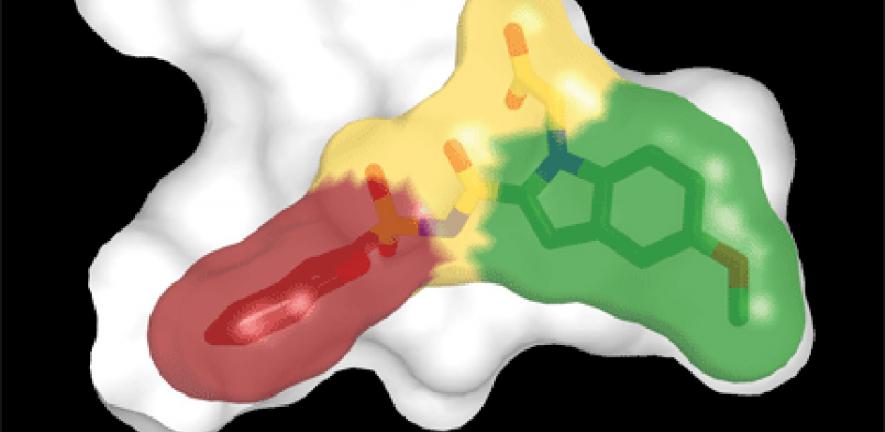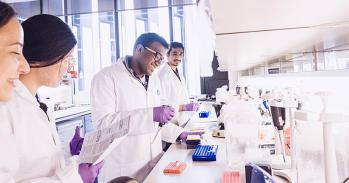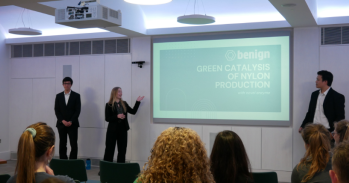
Cambridge scientists are employing fragment-based drug discovery approaches - a technique that involves "growing" potent drugs from tiny chemical fragments - to tackle tuberculosis and cancer.
Cambridge scientists are employing fragment-based drug discovery approaches - a technique that involves "growing" potent drugs from tiny chemical fragments - to tackle tuberculosis and cancer.
Preliminary data indicate that these drugs can kill the pathogen, there is great excitement within the TB research community about the potential for this technology to make inroads into a neglected disease area.
Professor Chris Abell
In the ongoing search for novel drugs to add to the armoury against disease, scientists are making use of new approaches to drug discovery that aim to increase the rate of success, decrease the development timeline and minimise the cost.
Conventional drug discovery approaches involve high-throughput screening of up to millions of large compounds to find those that inhibit the activity of the target, usually a protein. Although many drugs have been discovered this way, the technique is expensive and resource intensive, and there is a high attrition rate of hits failing to progress through the development process to medicines.
In recent years, a complementary approach has been developed that involves screening fewer numbers of small chemical compounds (fragments) to find those that bind to the target, and then using structure-guided chemistry to ‘grow’ these fragments into potent drug molecules by linking fragments together or modifying them synthetically.
Cambridge has been at the forefront of this new school of thinking. Over a decade ago, Professor Chris Abell (Department of Chemistry), Professor Sir Tom Blundell (Department of Biochemistry) and Dr Harren Jhoti (formerly Glaxo Wellcome) co-founded Astex Therapeutics, a company that pioneered and is now world leading in fragment-based approaches to drug discovery. Since then, these approaches have gained widespread recognition and are now being used throughout the pharmaceutical industry. Even in this relatively short space of time, Astex has used its technology to develop several compounds against cancer that are now in clinical trials.
Targeting tuberculosis
Several years ago, funding from the European Community and the Bill & Melinda Gates Foundation enabled Professor Blundell and Professor Abell to establish a programme of fragment-based drug discovery methods in the University, with collaborators in South Africa, India and the USA. The first target was tuberculosis (TB), a major cause of death in India and Africa. It has been estimated by the World Health Organization that over a third of the world’s population is infected with the TB bacterium, and that someone is newly infected every second. Despite this, no new drugs have been introduced against the bacterium for over 40 years. Fortunately, the field has received new impetus, in no small part due to the Bill & Melinda Gates Foundation, and groups in both academia and industry are working collaboratively to find new solutions and drugs.
Building on fundamental studies of vitamin biosynthesis pathways initiated by Professor Abell and Professor Alison Smith (Department of Plant Sciences), the scientists have focused on several key enzymes required by the Mycobacterium tuberculosis bacteria to infect lung tissue. Fragments that inhibit the enzymes’ active sites – essentially the heart of their functional activity – have been isolated and their potency improved by structural modification. ‘Preliminary data indicate that these drugs can kill the pathogen,’ said Professor Abell. ‘There is great excitement within the TB research community about the potential for this technology to make inroads into a neglected disease area.’
A new terrain
Meanwhile, the scientists are casting the net wider in drug discovery by employing fragment-based approaches to search for a particularly challenging class of drugs. Professor Abell and Dr David Spring (Department of Chemistry), Professor Blundell and Dr Marko Hyvonen (Department of Biochemistry) and Professor Ashok Venkitaraman and Dr Grahame McKenzie (Hutchinson/Medical Research Council (MRC) Research Centre), all key members of the Cambridge Molecular Therapeutics Programme, are making use of this new paradigm to search for drugs that interfere not with the active site of a protein but with the interaction of proteins with each other.
Protein–protein interactions are of vital importance to almost every pathway and process in living cells, and there is much interest in targeting the interfaces between two or more interacting proteins for therapeutic purposes. ‘However, the characteristics of these interfaces make this a particular challenge,’ explained Professor Abell. ‘Unlike the deep, pocket-like active sites of many proteins, which are the more usual targets of drug discovery, typical protein–protein interaction sites are large and relatively flat terrains, with shallower pockets. Considered too difficult to target, such interactions had largely been ignored by the pharmaceutical industry.’ Fragment-based methods, however, seem to have some advantages, in part because they bind to key hotspots on the surface, maximising the available binding interactions.
As a model system, a project coordinated by Dr Hyvonen and funded by the Wellcome Trust is investigating the interaction between human RAD51 and BRCA2 proteins, which work together to help cells repair damage to their DNA. When this process goes wrong, as found in individuals who inherit a faulty version of the BRCA2 gene, there is a greater chance of the cell becoming cancerous: indeed, defective BRCA2 is associated with a higher incidence of breast, ovarian and prostate cancer. Unravelling the mechanism underlying the activity of BRCA2 is an area of long-standing expertise of Professor Venkitaraman at the Hutchinson/MRC Research Centre.
The team is interested in finding a drug to block the interaction between mutated BRCA2 and RAD51, explained Dr Hyvonen: ‘By inhibiting this repair process, the cells will become more sensitive to DNA damaging agents and radiation, and a drug targeting this interaction could therefore be used to enhance current cancer treatments, radiation therapy in particular.’ Fragments have now been discovered that can inhibit the BRCA2–RAD51 interaction. X-ray crystallography of fragment–protein complexes has been used to guide chemical synthesis, growing the fragments in order to extend further into the same or to nearby pockets. The result is a fast, efficient and low-cost route to developing potential new cancer drugs.
Seeding new drugs
On the basis of these proof-of-concept studies, the Cambridge researchers have recently been awarded two major grants from the Wellcome Trust to develop small molecules that modulate protein–protein interactions.
The first award is a five-year Strategic Award (led by Professor Venkitaraman) to ask fundamental questions about how to target different kinds of protein–protein interactions. The second is an award from the Seeding Drug Discovery (SDD) initiative for a project led by Professor Abell to develop potent and specific compounds against a particular protein–protein interaction that may have value in the treatment of cancer.
‘The Strategic Award presents us with a great opportunity to improve the technology underlying this approach, and complements the SDD initiative’s specific milestone-driven focus on a project that has the potential to deliver therapeutic benefit,’ explained Professor Abell. ‘We hope that this work will draw the attention of the pharmaceutical industry and encourage them to look for new therapeutic targets for the development of novel medicines of the future.’
For more information, please contact Professor Chris Abell (ca26@cam.ac.uk) at the Department of Chemistry and Dr Marko Hyvonen (marko@cryst.bioc.cam.ac.uk) at the Department of Biochemistry.
This work is licensed under a Creative Commons Licence. If you use this content on your site please link back to this page.





